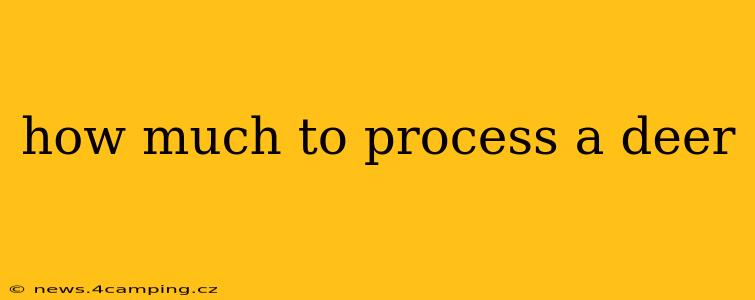How Much Does it Cost to Process a Deer? A Comprehensive Guide
The cost of processing a deer varies significantly depending on several factors. Understanding these factors will help you budget accurately and choose the right processor for your needs. This guide breaks down the typical expenses and helps you navigate the process.
Factors Affecting Deer Processing Costs:
Several key elements influence the final price you'll pay for deer processing:
- Location: Geographic location plays a crucial role. Processing costs tend to be higher in areas with higher labor costs and greater demand. Rural areas might offer lower prices than urban or suburban locations.
- Processor: Different processors have different pricing structures. Some might offer package deals, while others charge per service. Shop around and compare prices before making a decision.
- Services: The services you choose directly impact the cost. Basic processing typically includes skinning, quartering, and packaging. Additional services like sausage making, burger grinding, summer sausage, jerky, or bone-in cuts will increase the overall expense.
- Deer Size: Larger deer generally cost slightly more to process due to increased labor and material needs.
- Time of Year: Processing costs may fluctuate seasonally, potentially increasing during peak hunting seasons due to higher demand.
Typical Deer Processing Costs:
While prices vary widely, you can expect to pay anywhere from $50 to $150 or more for basic deer processing. This usually includes skinning, gutting, quartering, and packaging the meat.
Adding value-added services like:
- Sausage making: Expect an additional cost per pound of sausage produced.
- Burger grinding: This usually incurs a per-pound charge as well.
- Jerky: This is often priced per pound and can vary based on the type of jerky (e.g., traditional, teriyaki).
- Summer Sausage: This is another per-pound cost which will likely depend on the selected recipe and spices.
Additional Fees:
Some processors may charge additional fees for:
- Caping: Preserving the head and antlers for mounting.
- Transportation: If you're unable to transport your deer yourself.
- Taxidermy: Professional taxidermy services are separate from meat processing and can significantly increase overall costs.
How to Find Affordable Deer Processing:
- Shop around: Get quotes from multiple processors in your area. Compare services and prices to find the best value.
- Consider basic processing: If you're on a budget, opt for basic services and handle additional processing (like sausage making) yourself.
- Hunt during the off-season: Processing costs might be lower during less busy periods.
- Ask for package deals: Some processors offer discounts for multiple deer or combined services.
What Happens During Deer Processing?
Deer processing typically involves the following steps:
- Skinning: Removing the hide.
- Gutting: Removing the internal organs.
- Quartering: Cutting the carcass into manageable sections.
- Meat trimming: Removing excess fat and connective tissue.
- Packaging: Vacuum sealing the meat for optimal preservation.
How Much Meat Can I Expect from a Deer?
The amount of usable meat from a deer varies depending on the animal's size, age, and sex. You can generally expect to receive between 40 and 70 pounds of usable meat.
Can I Process My Own Deer?
Yes, you can process your own deer, but it requires time, skill, and the right equipment. If you lack experience, it's advisable to use a professional processor to ensure proper handling and food safety.
By understanding the factors influencing cost and comparing prices, you can effectively budget for your deer processing needs and enjoy the fruits of your hunting success. Remember to book your processing well in advance, especially during peak hunting seasons.
